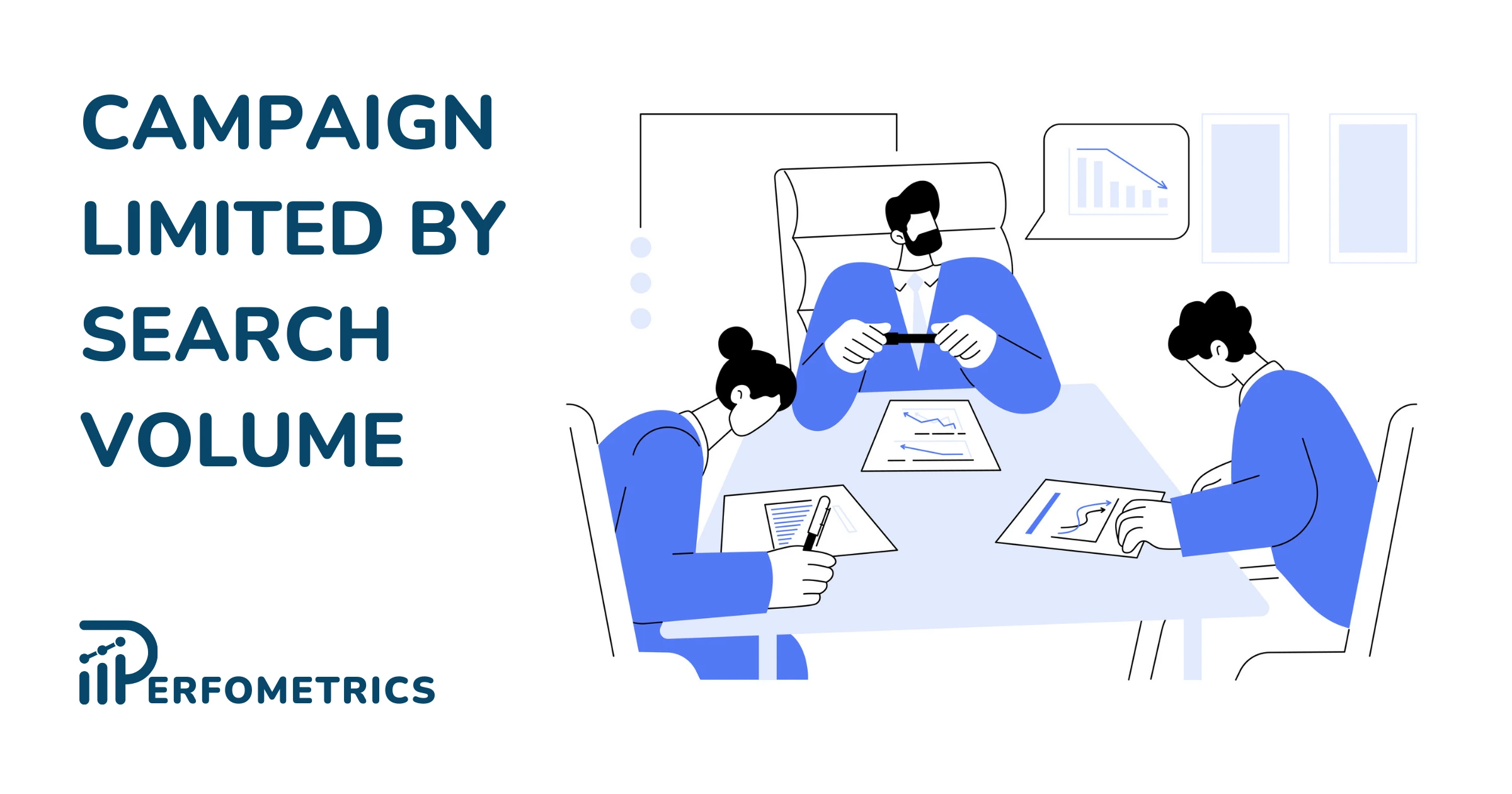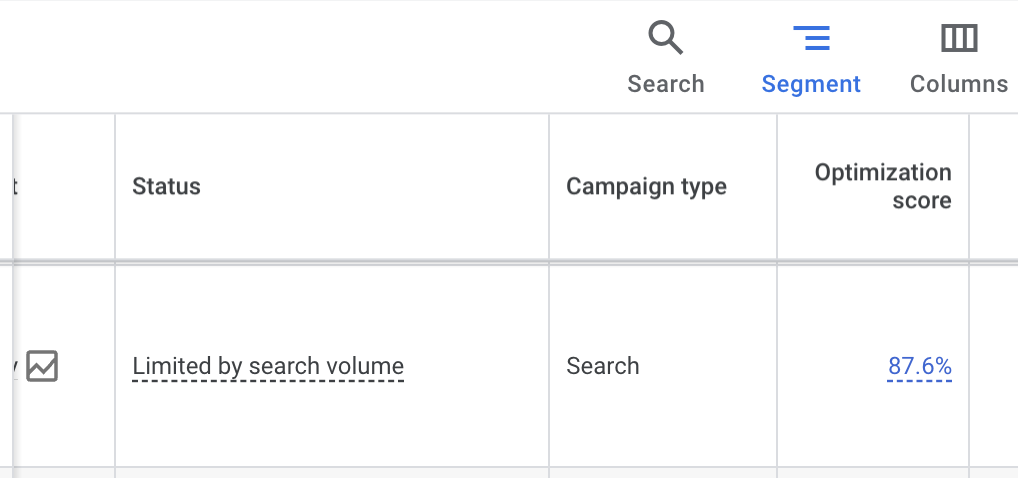Limited by Search Volume Campaign in Google Ads – 10 Steps To Fix It

Is your Google Ads campaign limited by search volume? We know it gets quite frustrating when your campaigns have been running well for a while and then you notice that your campaign volumes have been gradually decreasing, or your higher-up asks you to increase the volumes.
If your Google Ads campaign is showing the “Limited by Search Volume” or “Low Search Volume” status, this guide is for you. This common issue means your ads aren’t reaching enough people due to insufficient keyword searches. We will cover what “Limited by Search Volume” means, why it happens, and how to fix it and boost your campaign performance.
These suggestions can be applied to multiple campaigns, and some of them are quite unique to specific campaign types in Google Ads. But here are 10 different ways to help you fix low traffic volumes.

Understanding ‘Limited by Search Volume’ in Google Ads
The term ‘Limited by Search Volume’ in Google Ads signals a situation where your campaign’s visibility is suffocated due to insufficient searches because the targeted are low-volume keywords, the bidding strategies and objectives are too aggressive, or other targeting settings.

This impacts the campaign performance significantly as your ads remain unseen by potential customers, leading to low impressions, click-through rates, and click volume due to limited search queries. A clear understanding of this issue is the first step towards creating impactful campaigns.
Many advertisers wonder: what does ‘limited by search volume’ mean? It simply means your ads aren’t being shown as often as they could be because the keywords you’re targeting don’t have enough search traffic.
Gaining insights into the ‘Limited by Search Volume’ status requires analyzing key metrics such as search impression share. This metric measures the percentage of impressions your ads receive compared to the total number they were eligible to receive.
How to Increase the Search Volume of Google Ads Campaigns?
Here are 7 strategies to fix the ‘Limited by Search Volume’ Status in your campaigns; If you’re experiencing the “eligible limited” status, these steps can help improve your reach and visibility.
1. Revisit Your Keywords Selection, Volumes & Keyword Match Types
Low search volume keywords are those with minimal or no search history on Google, which means they generate very little search traffic. This mainly applies to Search Campaigns as they mainly focus on targeting keywords and therefore the type of keywords you pick plays an important role.
Identifying these keywords can be done by looking for keywords marked as ‘low search volume’ in your Google Ads account. Using tools like the Google Ads Keyword Planner can also help assess the potential volumes of the targeted keywords.
If you are using exclusively Phrase Match keywords or Exact match keywords then sooner or later your campaign will have the status “Limited by Search Volume”. In which case the recommendation by Google will be to add broad match keywords to open up the volume. We recommend going slow and testing broad keywords one by one.
Adding broad keywords will not only help with increasing the volumes but also give room to the algorithm to learn what works the best and even improve the performance of your campaigns.
If you need new keyword ideas you can turn to the Search Terms Report for new ideas and variations and the Keyword Planner is your best friend. You can check out our article on how to get the most out of the Keyword Planner Tool. Make sure to use it as much as possible, it’s a great tool to help you find new keywords and explore new worlds.
A very last option to consider is bidding on a competitor’s name. This can be also a tremendous source of traffic, but be extremely careful because it can easily backfire. The competitor, especially if a bigger one can start bidding on your brand name, and you’ve essentially created a bidding war where CPC and costs can quickly skyrocket.
2. Align the Campaign Bidding Strategy and Objectives
Another reason why your campaign may be limited in volume is the strategy itself. Especially in the case of Target CPA and Target ROAS (Return on Ad Spend). In this instance, the campaign may be signaling a status, “Limited by Strategy” most likely because the defined tCPA or tROAS is too limited. This can also happen with a Max Clicks strategy when the defined Max CPC is too small. Loosening up these targets, within the limits of possibility that is, can help you increase the volumes.
It’s important to analyze and understand your objectives of the campaign because if the targets are too aggressive this can limit the available pool of conversions that the campaign can receive for the selected keywords and the daily budget.
Striking a good balance between the available budget, the number of target keywords, their volumes, their match types, the bidding strategy, and the campaign target is crucial in helping you fix the ‘Limited by Search Volume’ status.
Usually, a change of 10-15% is the most recommended and safest as bigger changes than that can have an important impact on the algorithm and disrupt it to a point where it goes back to learning mode.
You can also test out a more open strategy like Max Conversions or Max Conversions Value, but be sure that you don’t have specific targets to achieve like CPA or ROAS. To find out which strategy best fits your needs, check out our detailed article on the different bidding strategies in Google ads.
3. Review Targeting Settings (Audiences, Locations, Time Schedule, Devices & Bid Adjustments)
These campaign settings can be a big reason for the decrease in traffic. Limiting them too much will inevitably translate into low traffic volumes. Every business is different, runs in different areas and during different times of the day or week, but if you can, check to see what are the options to open these settings up as much as possible.
Increasing the target location or extending the time schedule can help you boost the volumes. Also, be wary of the bid adjustments you make, adding a location as excluded by mistake can have an important impact on your volumes. Finally, if you are running manual strategy or Max Clicks, have a look at your bid adjustments, they may be impacting also your volumes.
If you are running Search Campaigns, in the settings of your campaigns, check your “Networks”. Enabling Search partners and a Display Network will help you generate more traffic. The only downside of this is the quality. Don’t expect crazy performance from these networks.
Also in the campaign settings, check your Language Targeting. If you can select more languages than one, make sure to do so, it can help you show your ads to many more people.
This applies to almost all of the campaigns, from Search Campaigns to Display and YouTube. When implementing a new audience, be clear on what option you chose. Google will give you the choice to either select “targetting” or “observation”. Observation or targeting, which one to choose?
If it’s an audience you’d only like to observe and not target then make sure to select observe. Selecting “target” tells the campaign to specifically target the people within that audience that meet the predefined criteria. This can limit the overall traffic the campaign can receive, but even if you meant to target a given audience, the criteria may be too narrow and specific which would limit the overall volume that could potentially be reached (applicable also in Facebook Ads). For more details check out our in-depth article on audiences in Google Ads.
4. Improve Your Ads & Ad Extensions (Assets)
Today’s marketing landscape requires a lot of testing of ad copy and creatives, so make sure that you have multiple ads running with multiple headlines, descriptions, images, videos and ad extensions.
So if you’re not fully utilizing the available spaces in your ads make sure to add more and get different variations. It’s highly recommended to add them right away as they can help generate more clicks and volumes.
Check also your extensions, if you don’t have a sufficient amount, most probably Google will send you recommendations to add more extensions to your ads as they help improve the CTR and also bring more volume.
Another setting in the campaigns you may want to check is the “Ad Rotation”. Setting it to “Optimize: Prefer best performing ads” may also help you show your best ads which would help drive more traffic by increasing the CTR.
Another recommendation is to keep an eye on your “ad strength”. You can add this column and try to keep your ad strength at Good or Excellent if possible.
Another powerful but quite hidden tool to help you better assess the performance of your ads is the Asset report. It gives insight into the performance of each asset of your ads such as headlines, descriptions, pictures, and videos. To learn more about it check out our article on the assets report for responsive ads.
5. Implement Google Ads Recommendations to increase the Optimization Score
Implementing Google Ads recommendations to increase the Optimization Score can help combat low search volumes. The Optimization Score is a measure of how well your Google Ads account is set up to perform. A higher score indicates that your account is more likely to generate conversions and meet your advertising goals.
One of the ways to improve your Google Ads Optimization Score is to implement the recommendations that Google Ads provides.
These recommendations are based on Google’s data and analysis, and they can help you improve your account’s performance in several areas, including:
- Keyword targeting: Google Ads can recommend keywords that are more relevant to your target audience and have a higher search volume. This can help you attract more relevant traffic to your website.
- Bidding strategy: Google Ads can recommend bidding strategies that are more likely to achieve your advertising goals. This can help you improve your Cost Per Acquisition (CPA) and return on investment (ROI).
- Ad copy: Google Ads can recommend ad copy that is more likely to get clicks and conversions. This can help you increase your click-through rate (CTR) and conversion rate.
6. Keep Your Google Merchant Center Up To Date & Healthy
If you are running Google Ads Shopping Campaigns, today known as Performance Max and experiencing low volumes you should check your Google Merchant Center (GMC) and see if you have any disapproved products.
We recommend that you do this regularly because Google checks your product feed and the moment something has changed on the page it could have an impact on your products as well and get them disapproved. Make sure all your products are approved and running smoothly, if you have any disapproved ones fixing them will help you regain your traffic volumes.
7. Test Out Different Types of Campaigns
If you have done everything well, your campaigns are running great but you are still looking for more volumes there are a few more things you can try out. If you haven’t already you can test out campaigns such as Discovery Campaign or even Performance Max Campaign which is currently in beta.
These campaigns take a more global approach and aim to bring a lot of traffic, build brand awareness, and also generate conversions. In simple terms, they are a 3 in 1. Search, Display, and YouTube all in one and they can be a great way to bring new traffic. Not so much recommended from our side, but if you are really in need of more volume, you can try out Dynamic Search Ads.
These types of campaigns are fully autonomous, they are very personalized and they adjust to each customer. The way they work is they crawl your website and they take care of practically everything except for the descriptions, which you have to provide. There are some benefits to creating Dynamic Ads and Ad Groups, but unavoidably there are some things you should be careful about.
In the case where you don’t have much data in your campaigns, you can use Google Trends to get estimated data for longer time frames. It could also be that the drop in traffic can be explained by new competitors arriving on the market. Have a look at your Auction Insights in Google Ads to identify if a new player has joined the game, to do the same you can refer to other external tools such as SEMrush, SimilarWeb, or Ahrefs.
FAQ: Limited by Search Volume in Google Ads
This section answers common questions about the “limited by search volume” status in Google Ads.
| Question | Answer |
|---|---|
| What does “Limited by Search Volume” mean in Google Ads? | “Limited by Search Volume” is a status in Google Ads indicating that your keywords or campaigns are not triggering ads frequently because there aren’t enough searches for your targeted terms. This results in low impressions and reduced ad visibility. |
| How can I fix ‘Limited by Search Volume’ in my campaigns? | Add higher-volume keywords or broaden match types. Adjust your bidding strategy to be less restrictive. Expand your targeting (locations, languages, devices). Review and improve your ad copy and ad extensions. Implement Google Ads recommendations to boost your Optimization Score. |
| Do low search volume keywords affect Quality Score? | Low search volume keywords typically do not impact your Quality Score directly, but they can limit your campaign’s reach and efficiency. It’s best to focus on keywords with enough search volume to generate meaningful data and results. |
| What should I do with low search volume keywords? | Pause or replace them with broader or more relevant terms, or group them in separate ad groups to monitor performance without dragging down your main campaigns. |
| How do I increase search volume for my Google Ads campaign? | Use the Keyword Planner to find higher-volume keywords. Test broad match or broad match modifier keywords. Expand your geographic and language targeting. Consider new campaign types like Performance Max or Demand Gen. |
| What does ‘Eligible (Limited)’ mean in Google Ads? | “Eligible (Limited)” often means that while your ad is technically able to run, it’s not showing as much as it could due to factors like low search volume, budget constraints, or policy issues. |
| What is the difference between “low search volume” and “limited by search volume”? | “Low search volume” refers to keywords that don’t have many searches, while “limited by search volume” is a campaign status indicating that your ads aren’t showing as often as they could because of those low-volume keywords. |
| How do I check search volume for my keywords? | Use the Google Ads Keyword Planner or third-party SEO tools like SEMrush or Ahrefs to research the average monthly searches for your target keywords. |
| Does “no search volume” mean the keyword is useless? | Not necessarily. It might mean the keyword is very niche or specific. While it won’t bring a lot of traffic, it could still be valuable if it perfectly matches what your target audience is looking for. Consider if the specificity outweighs the lack of volume. |
| Why is my Google Ads campaign not getting impressions? | Several factors could be at play: low search volume for your keywords, restrictive targeting, low bids, or issues with your ad copy or landing page. Review each of these areas to identify the problem. |
| How do I target high-volume keywords without wasting my budget? | Use a combination of broad match (with careful monitoring and negative keywords) and more specific match types. Start with a moderate budget and gradually increase it as you optimize your campaign. |
| What does search volume actually indicate? | Search volume is an indicator of the popularity and interest in the keywords that you are targeting. More searches usually means more interest, which in turn will mean more impressions, clicks, and conversions. |
Our Final Thoughts
Sometimes with the current setup and objectives of the campaign, getting additional volumes can be tricky.
Another thing you can do is compare Microsoft Ads vs Google Ads, and if their solution supports your objectives test out expanding into a different ad tool covering various search engines like Microsoft Ads.
In some instances, it may be simply better to test out different traffic sources like Facebook, Instagram, LinkedIn, podcasts, or even more traditional ones like radio and TV.



